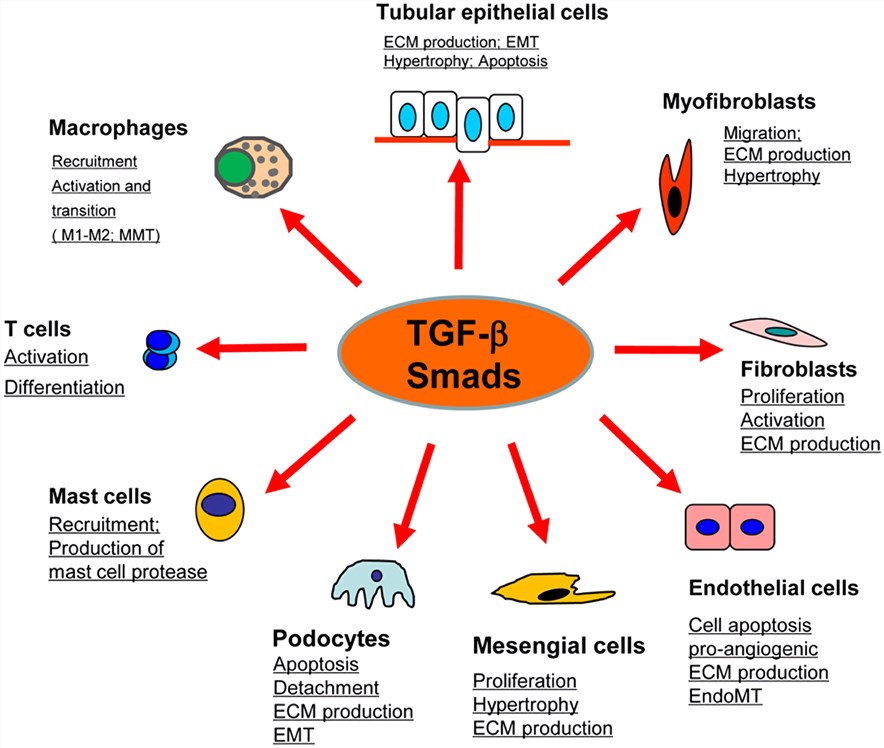NASH Target Development Service for Tissue Growth Factor-beta (TGFβ)
Researches indicated that non-alcoholic steatohepatitis (NASH) development is also closely associated with TGF-β, a critical cytokine with numerous regulatory functions and comprehensive distribution. As your best partner, Creative Biolabs is very glad to provide our professional NASH services to promote your success.
What is Transforming Growth Factor-beta?
Transforming growth factor-beta (TGF-β) is a large class of cytokines with multiple biological functions at the cellular level and at the tissue or organism level. TGF-β family is composed of many proteins, including three different mammalian isoforms (TGF-β 1, TGF-β 2, TGF-β 3), activins and bone morphogenetic proteins, which are pleiotropic cytokines eliciting cell type-specific effects in a highly context-dependent manner in many different tissues. All TGF-β isoforms are extracellular proteins that share highly similar regions in their peptide structures (homologies on the order of 70-80%). These secreted protein ligands signal through a single transmembrane type I and type II serine/threonine kinase receptor and an intracellular transcription factor named Smads. Actually, TGF-β is extensively expressed by various cell types like lymphocyte, hematopoietic, neuronal, epithelial, and connective-tissue cells, etc. Because of their diversity and ubiquitous distribution, TGF-βs and their involved signaling pathways exert profound effects on a broad spectrum of bioactivities and processes, such as cell signaling, cell cycle, apoptosis, angiogenesis, fibrosis, inflammation, immunological reaction and so forth.
 Fig.1 TGF-β/Smad signaling exerts biological activities on different cell types. (Meng, 2015)
Fig.1 TGF-β/Smad signaling exerts biological activities on different cell types. (Meng, 2015)
Transforming Growth Factor-beta (TGF-β) for NASH Treatment
TGF-β signaling activates Smad-dependent and TGF-β-activated kinase 1 (TAK1)-dependent signaling to regulate cell survival, proliferation, fibrosis, and tumorigenesis. The essential and pleiotropic functions and regulations of TGF-β help maintain the homeostasis of tissues and organs in different pathways. Abnormality of TGF-β can result in many disorders and diseases including cancers, cardiac disease, diabetes, renal diseases, etc. It and related signaling pathways are closely related to all stages of hepatic disease progression, ranging from hepatic inflammation, steatosis, liver fibrosis to NASH and cirrhosis, and even hepatocellular carcinoma. TGF-β shows moderate cytostatic and apoptotic effects on hepatocytes while high levels of it can lead to chronic liver damage, hepatic fibrosis, and NASH.
Numerous studies have been conducted to reveal pathological mechanisms of TGF-β signaling contributed to NASH, which are caused by complex and multifaceted approaches. It is indicated that TGF-β signaling promoted lipid accumulation with induction of lipogenesis-related genes and suppression of β-oxidation-related genes in hepatocytes. Based on these studies, TGF-β is definitely a potential small molecule target in NASH therapeutic development. It is noteworthy that (i) there are several isoforms and many related or downstream active proteins of TGF-β, (ii) extensive expression and multiple functions. Considering these, antagonists that specifically target TGF-β in the liver would be the ideal novel therapeutic approaches for NASH.
Based on years of service experience and professional scientific research teams, Creative Biolabs can offer a broad spectrum of best NASH services including Biomarkers for NASH Diagnosis, Target Discovery and Therapeutic Strategies and Preclinical Models of NASH. If you have any questions, please contact us. Our scientists can customize our service to meet your specific project needs.
Reference
- Meng, X.M.; et al. TGF-β/Smad signaling in renal fibrosis. Frontiers in Physiology. 2015, 6: 82. Distributed under Open Access license CC BY 4.0, without modification.
 For Research Use Only.
For Research Use Only.